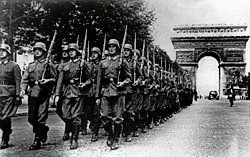Prelude to Fall Rot: The Strategic Context and Preparations
The initiation of Fall Rot (Case Red) on June 5, 1940, marked a pivotal point in World War II, following the earlier campaign known as Fall Gelb (Case Yellow). By the end of May 1940, German forces had successfully executed Fall Gelb, which entailed the rapid invasion of France and the Low Countries. This initial phase culminated in the encirclement of Allied forces at Dunkirk, leading to the evacuation of over 300,000 British and French troops. Despite the evacuation, the Allied forces were left significantly weakened, setting the stage for the German high command to plan and initiate Fall Rot.
German military strategy for Fall Rot was deeply informed by the successes and lessons of Fall Gelb. The German High Command, led by figures such as Generalfeldmarschall Gerd von Rundstedt and Generaloberst Franz Halder, recognized the need for swift and decisive action to capitalize on their momentum. The strategic objectives of Fall Rot were clear: to break through the remaining French defenses, capture Paris, and force the French government into surrender. Intelligence reports and reconnaissance efforts played a crucial role in shaping these plans. The Germans meticulously gathered data on French troop movements, fortifications, and logistical vulnerabilities, allowing them to craft a strategy that emphasized speed and surprise.
The German forces were strategically composed of several army groups. Army Group A, under the command of Generaloberst Gerd von Rundstedt, was positioned to strike through the Ardennes, while Army Group B, led by Generaloberst Fedor von Bock, aimed to press towards Paris from the north. Meanwhile, Army Group C, commanded by Generaloberst Wilhelm von Leeb, was tasked with pinning down the French forces along the Maginot Line. The French, on the other hand, were grappling with depleted resources and morale, their defenses stretched thin across a broad front.
Key historical documents, such as the directives issued by Adolf Hitler and the operational plans of the Wehrmacht, provide valuable insight into the meticulous planning that preceded Fall Rot. These communications reveal a highly coordinated effort to exploit the weaknesses of the French defenses and achieve a rapid conclusion to the campaign. The stage was thus set for Germany’s major offensive in northern France, a move that would profoundly alter the trajectory of the war.
Execution and Aftermath: The Fall of Paris and the Establishment of the Vichy Government
The execution of Fall Rot commenced with the German forces crossing the River Somme on June 5, 1940. This marked the beginning of a relentless advance that quickly overwhelmed French defenses. The Germans employed blitzkrieg tactics, characterized by swift, coordinated attacks combining air power and mobile ground units, which proved devastatingly effective. Key battles, such as the encirclement of French divisions at the Battle of Abbeville, highlighted the prowess of German strategy and the inadequacy of French preparations.
The rapid advance continued unabated, leading to the fall of Paris on June 14, 1940. Paris, a symbol of French resilience, was taken with minimal resistance, profoundly impacting both military and civilian morale. The demoralization was palpable; French forces, stretched thin and lacking coordination, could not mount a meaningful defense. This swift fall demonstrated the superiority of German military tactics during this phase of World War II, specifically the effectiveness of blitzkrieg in achieving rapid and decisive outcomes.
Following the fall of Paris, the situation for France became untenable. On June 22, 1940, an armistice was signed at Compiègne, leading to the formal surrender of France. This agreement resulted in the occupation of northern and western France by German forces, while the southeast was left under the control of the newly established Vichy government. The Vichy regime, led by Marshal Philippe Pétain, collaborated with the German occupiers, creating a complex political situation that facilitated further German control over French resources and infrastructure.
The immediate consequence of the German occupation was the significant impact on French resistance movements and the Allied war effort. While the Vichy government sought to maintain a degree of autonomy, it was largely seen as a puppet state, ultimately undermining its legitimacy. The occupation galvanized resistance movements within France, although these were initially fragmented. Over time, however, these movements gained cohesion and strength, playing a crucial role in the eventual liberation of France.
The long-term implications of Fall Rot were profound. The German occupation of France not only altered the dynamics of the European theater of World War II but also had lasting effects on French society and politics. The collaborationist Vichy regime remained a contentious issue in post-war France, influencing political discourse and shaping the nation’s collective memory of the war. The effectiveness of German tactics during Fall Rot provided valuable lessons for military strategists, illustrating the importance of speed, coordination, and psychological impact in modern warfare.
For further reading on these events and their implications, readers are encouraged to consult historical archives, academic papers, and credible sources such as the International Military Archives and the World War II Database. These resources offer detailed accounts and analyses that complement the narrative provided here.

